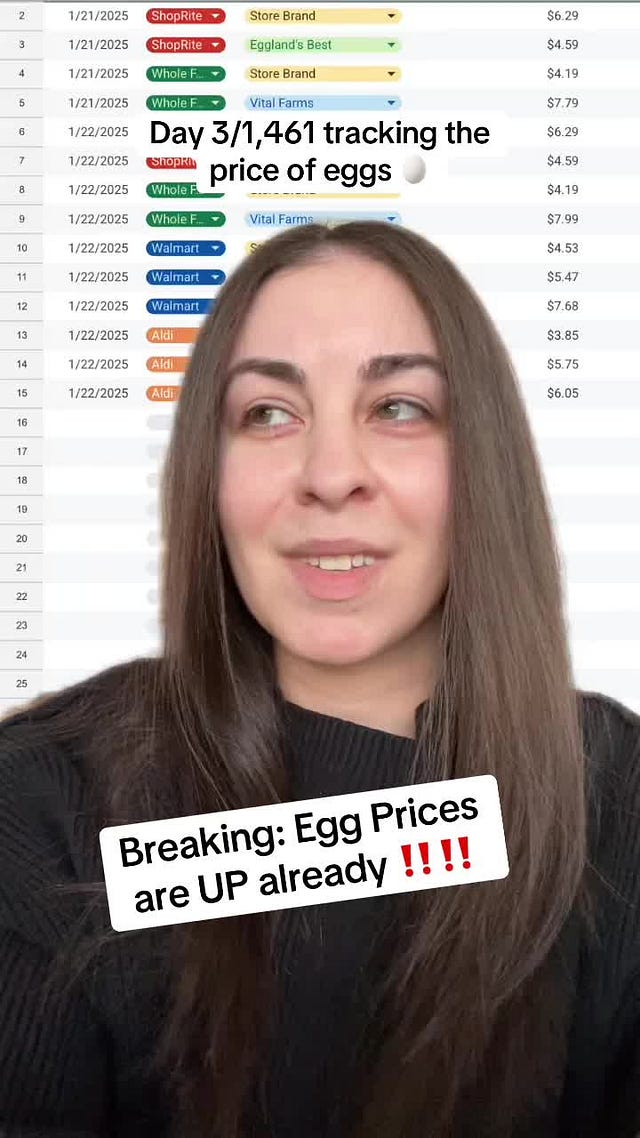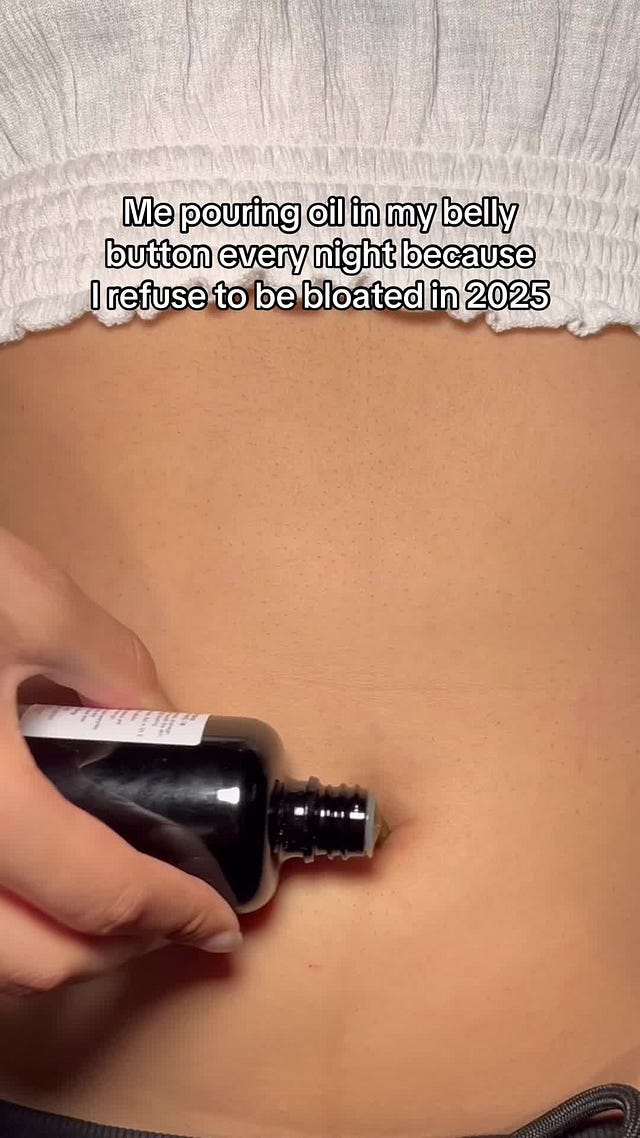President Trump has been a VERY busy man. His first day back in office saw him deliver on some big promises: withdrawing the U.S. from the WHO and Paris Climate Agreement, declaring the federal government will recognize only two genders, scrapping DEI policies, pardoning January 6 Insurrectionists, and deploying ICE raids. One campaign promise, however, has slipped under the radar: lowering the price of eggs.
Lucky for us, this TikToker is fulfilling her civic duty and tracking the price of eggs for the next 1460 days under Trump’s administration. And to no surprise, the price of eggs has already gone up…
In non-egg news…
Should I start pouring oil in my belly button? Somehow, I’ve made it to the side of TikTok where wellness girlies are obsessed with castor oil—specifically pouring it in their belly button to minimize bloating and support digestion. Whether or not these health claims are indeed true (at minimum there’s no major risks of doing so), this ancient Ayurvedic practice has gained popularity among consumers that mostly don’t know how or where the practice originated. This isn’t cultural appropriation per se, but it’s interesting how TikTok has become a catalyst for pulling cultural traditions into the mainstream. Back in 2021, it was Gua Sha and now it’s Nabhi Chikitsa.
I don’t think matcha’s just having a moment, it’s here to stay. The global market for matcha is currently worth around $4.25B and is expected to grow 53% by 2029. Economic stats aside, matcha has gained influence in the social sphere—from over 15B views of #matcha on TikTok, the fact that you can be a “matcha influencer” (ex: Kimi, Meredith Mao), to the rise of creator-led matcha brands (ex: Nami Matcha, Chamberlain Matcha & Sisters Matcha). Matcha is everywhere, especially online. So what’s fueling matcha’s popularity? Younger generations are known to be more health-conscious, and matcha is considered a better-for-you alternative to coffee, given it’s slow release of caffeine (thank you L-theanine). Another driver, which I think is less talked about, is the greater adoption of slow living. Traditionally, matcha making is a ritual. First, you sieve your matcha powder. Then you whisk, and then you can sip. Rather than just putting a pot of coffee on, making good matcha takes time and that’s partly why morning matcha videos have been trending. I have so much more to say about matcha, which I’ll save for another day!

credits: wylde.one Speaking of matcha, everyone also wants to smell like it. Expect matcha, rice milk, and sesame in fragrance launches this year. In general, the fragrance industry is expected to boom as it’s become more than a product—it’s a form of self-expression. Gourmand scents, in particular, are rising in popularity as consumers seek out multi-sensory experiences. There’s a growing appetite for notes that smell good, and taste good.
I’m just really loving underconsumption core. #UnderconsumptionCore has been trending since the end of last year. Unlike many other trends that die out quickly, underconsumption core is still a thing. At the heart of it, people are romanticizing buying and using only what you need. Think anti-shopping hauls that social media influencers often promote. We’re constantly being told what to buy, and often encouraged to buy more in the pursuit of social capital. I personally welcome mindful consumption, sustainability, and saving money.
Brandscape’s piece '5 strategies CPG startups are using to grow right now’ is a must-read for founders and marketers, especially in CPG. In a nutshell, what’s working is: building in public, tapping into niche communities, getting into retail quickly, experimenting with new platforms, and staying on-trend with design.
One CPG brand that’s utilizing these ^^ strategies effectively is Beny Yogurt.
has become the face of the brand across socials. Seeing her grow Beny’s audience is observing a playbook on community building + organic marketing in action. Through authentic story telling—from insights into why she “quit her job in private equity to start a yogurt company her best friend” (what a hook!) to DIML videos—Beny has cultivated a highly engaged community in just a couple of months. This CPG brand is definitely one to watch.Back to Nature rebranded and it looks like any other new CPG brand.
I think a lot about Gen Z branding. My hot take is that a lot of new CPG brands share a very similar aesthetic—one that’s very colorful, bold, and sometimes a little bit retro. At first, this design aesthetic felt fresh and disruptive. But now, new CPG brands are losing uniqueness simply because they want to look trendy. It’s all a blur of color IMO.
The FDA’s proposal to mandate front-of-package nutrition labels is going to be a nightmare for packaging designers. This announcement comes just a week after the FDA banned Red Dye No. 3, and last month they formally changed the definition of “healthy”. If brands have to include a nutrition label on the front, packaging design is never going to be the same again. The front label is going to take up prime real estate. Quite frankly, it’s going to make packaging designs look hideous. On the flip side, this might give older brands an opportunity to rebrand and modernize their existing packaging.
I’ll end with some piping hot 🍵 This male VC thinks that Alex Cooper’s beverage brand will be a flop because he’s never seen a woman drink Gatorade or Body Armor. He couldn’t be so wrong. I didn't know LinkedIn posts could get so spicyyy. Long story short: Scott Van den Berg, Founder of HotStart VC posted earlier this week saying that the motivation behind launching Unwell was Alex Cooper’s frustration with seeing hydration drinks primarily marketed toward men. Scott’s not convinced that this is enough to make Unwell successful, because Alex Cooper’s main audience doesn’t consume existing popular hydration brands. Commenters, especially women, fired back.
Scott, respectfully, just because you (someone not in the female demo) don't see women drink gatorade means or similar drinks means nothing. You are completely missing the market opportunity and this shows the problem with VC funding being completely biased towards the male perspective. Remember, women control much of consumer purchase behavior. And while I'm not a fan of the name, there are plenty of women who are health conscious and want more drinks that have electrolytes and great packaging like this. I have 3 brands of electrolyte drinks in my fridge right now, and none are gatorade which i'd classify in the sugar/soda category.
Beyond making assumptions about female consumption behavior (as a male consumer), Scott completely dismissed the fact that women represent tremendous spending power. In 2023, women accounted for 85% of purchases in the U.S. and this number only continues to rise. While I too, don’t love the brand name “Unwell”, Alex Cooper has access to a huge audience of women who care about wellness, and actually care about hydration too.
🙋🏼♀️ where else to find me?!
call me gen z but i’m most active on tiktok, then on instagram.
food baby club is a weekly newsletter covering insights at the intersection of food, culture & design. if you enjoyed reading this, please consider sharing with a friend 💚










thanks for the mention too! I'm so glad you appreciate the strategy and excited to keep growing!
Thanks for the mention! I agree with you on Gen Z branding fatigue — it’s definitely time for something new! Looking forward to reading your matcha deep dive soon 🍵⭐️